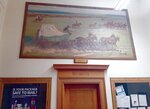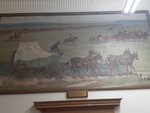

High on the west wall of the lobby of the Gatesville Post Office hangs a large mural which was painted in 1939 by a young artist named Joe De Yong of California. The mural titled “Off to Northern Markets” was commissioned by the Works Progress Administration (WPA) during the Depression when several hundred young artists were engaged to paint murals for post offices and other public buildings. It was reported that the idea behind the project, sponsored by the U.S. Treasury Department, was to keep the country’s top artists busy so that they wouldn’t lose their talent during that turbulent time in U.S. history.
Gatesville Postmaster J.H. McClellan received word that Gatesville would receive a mural in De Yong’s own hand. The artist would later explain that there was a government competition open to the public in connection with the submission of ideas and preliminary sketches for murals to be hung in various post offices across the land. Close to a year later, McClellan received a letter from De Yong informing him that the mural was complete. He was prevented from delivering the canvas to Gatesville himself due to his ill health. De Yong relegated the task of mounting the mural to W.E. Dawson of William Cameron Company of Waco.
Soon after he painted “Off to Northern Markets,” De Yong began corresponding with McClellan, in which he would elaborate on the mural in detail. In one letter, De Yong stated that the mural was intended to be related to the opening of Texas in an economic way due to the trail herds. “In this mural, I have shown the head end of the herd, the point and the wrangler, with part of the saddle horse and the cook with the chuck wagon passing the herd early in the day,” De Yong wrote. “Due to the size of the canvas, I had to make the wrangler and the chuck wagon pass closer to the herd than would be advisable ordinarily. Also, I could not show as many saddle horses as would be needed with such a herd. Sometimes art has its limitations.”
Joseph “Joe” De Yong was born in 1894 in the small town of Webster Groves, Missouri, the only child of Adrian and May De Yong. When he was five years old, the family moved to Dewey, Oklahoma, where his father would run a general store. It was while living in Indian Territory that young Joe became enamored with cowboys, and everything associated with life in the west. He even received a saddle for his sixth birthday which he would use in the summer months to help with cattle roundups and brandings even at the young age of six. When Joe De Yong was ten years old, he met the famed Will Rogers at his grandmother’s home in St. Louis. Rogers was in town for the 1904 St. Louis World’s Fair where he was entertaining the crowds with his trick roping skills and cowboy humor – this meeting only intensified young Joe’s fascination with the “Old West.”
He soon became fascinated with the film industry when he began wrangling cattle and horses in a movie. Silent film star Tom Mix had brought “a moving-picture troop” to the area to make a film called “Life on the Diamond-S Ranch,” which was shot on the Horseshoe L Ranch where Joe worked. In 1913, the young man was later hired to make a film with Tom Mix in Prescott, Arizona, but De Yong’s film career would be cut short when he contracted cerebral meningitis while working with Mix. The actor sent an urgent telegram to Joe’s parents to inform them of the serious condition their son faced. De Yong would ultimately recover but would remain totally deaf for the rest of his life, thus ending any plans he had for life on the range and on film.
In 1916, with the help of his friend, the famed Will Rogers, De Yong began to correspond with and ultimately meet the great western artist of the day, Charles M. Russell. His correspondence with Russell would ultimately change his life forever. In his later years, De Yong would write “while I had become familiar with Frederick Remington’s work, I had first seen the work of Charlie Russell – Montana’s cowboy artist – at the St. Louis World’s Fair in 1904. Russell’s work, of the two, his drawing and modeling of action was far superior to that of Remington.”
Eventually, Joe and his parents moved to Montana where Russell lived and the two developed a close bond and friendship. In the following months, De Yong began living with Charles and Nancy Russell, where he learned about the different mediums of art and helped in Russell’s art studio. Over the years, De Yong became known as Russell’s first and only student and protégé. He lived and worked with Charles and Nancy Russell for 10 years until Russell’s death in 1926. Learning at the hand of one of America’s foremost western artists, in addition to his early life spent among cowboys and Native Americans, enabled De Yong to paint western scenes as he recalled seeing them.
Following his art studies with Russell in Montana, he moved to Santa Barbara, California where he continued his career as an artist and illustrator. He was discovered by Hollywood movie producer and legendary director, Cecil B. DeMille. DeMille, having the reputation of being a well-known stickler for authenticity, felt very fortunate after hiring De Yong. He would later recommend De Yong to other directors by writing “I think it would be well worth your while to consider him if you are interested in having the best-informed man in the world on western Americana work with you.”
In 1944, 20th Century Fox was producing an epic Technicolor hit, “Buffalo Bill,” starring Joel McCrea, Maureen O’Hara, Anthony Quinn and Edgar Buchanan. During rehearsals, the studio had to send white men to teach the Native Americans how to fight “Indian-fashion.” The chief instructor for this task was Joe De Yong who was considered the greatest living authority on American Indians. He had studied various tribes and had lived among them for years. He was never able to learn their dialects due to his deafness, but he conversed with them fluently through their sign language. His knowledge of Native American dress, customs, and lifestyles benefitted the movie studios a great deal.
De Yong’s career would include work in Hollywood on numerous classic westerns and be became a tremendous influence in the lives of other western artists. Despite his handicap of being totally deaf, he went on to be a western consultant on such movies as “The Plainsman,” “Wells Fargo,” “Red River” and most notably, the 1953 film, “Shane,” which later became a classic. He became known as a technical and historical advisor in any media dealing with a western theme. De Yong was considered a dominant influence in how the West was portrayed for decades, from the film days of John Wayne and Gary Cooper to the later much-acclaimed mini-series “Lonesome Dove.” In all, De Yong was a great influence on preserving Western American culture as a historic consultant, set illustrator and costume designer on at least 21 major motion pictures.
De Yong died on April 16, 1975, at his home in Los Angeles at the age of 81. His remains were taken back to Great Falls, Montana, where he was buried at Highland Cemetery near his mentor and close friend, Charles Russell. He was considered not only a western artist but an illustrator, creative consultant and most importantly, a genuine cowboy. In his later years, Sam and Roberta Powell, of Gatesville, visited De Yong in his Hollywood home and they described him as being “a most interesting person.”
In his later years, Gatesville postmaster J.H. McClellan would write to De Yong and relate to him that the mural he painted “continues to receive very favorable comments. It adds much to the lobby of our office, fits well into the early history of Texas, and we believe is deserving of the credit it is receiving.”
Ironically, it was reported that Joe De Yong never visited the great state of Texas.